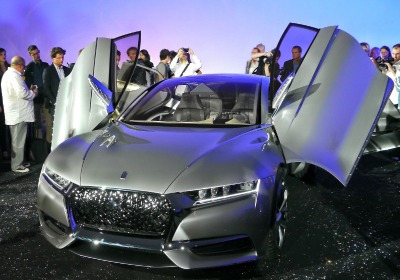First Sight: Divine DS concept
Fri, 05 Sep 2014To mark 100 days since the announcement that DS was to become a brand of its own, separate from Citroën, it has created the Divine DS concept – a self-styled manifesto for the new marque.
We traveled to Citroën's DS' design center on the southern outskirts of Paris to be amongst the first to see this statement of intent and speak to the people behind its creation.
"This concept car is the very essence of what DS is and what it will be," declares Yves Bonnefont, the CEO of the DS brand. "A perfect alliance between sophistication and technology." Next to take the stage was DS design boss Thierry Metroz: "It's a vehicle that will bear the essence of French cars to the future," he says. "This marks a return to the great moments of French coachbuilding." At this point images of Delages, Figoni et Falaschi-bodied Talbot Lagos and Delahayes flash through my mind...
The Divine DS is a 4.2-meter front-wheel drive C-segment hatchback, so it certainly doesn't evoke the likes of Henri Chapron's work with its proportions. However the arcing roofline does lend a little character to its silhouette, while bringing to mind the 2009 Citroën Revolte concept. "It's a C-segment because it's a core European market," explains exterior designer Frederic Soubirou (also responsible for the Revolte). "We have to be able to apply the brand to the whole range, so we didn't want to do a large coupé for example."
Can this coachbuilding heritage be found in its surfacing, then? There's certainly some drama in the flicked-out, rising rocker surface that – alongside the similarly chrome-edged, undercut beltline – creates a great deal of section through the bodyside. "We wanted to create something muscular, sinewy that's intersected by sharp lines," says Soubirou. But it has to be said that beyond this, the Divine's surfacing is thoroughly conventional.
Instead it would appear DS' strategy to achieve 'premiumness' is through the extreme use of detailing. From the floating diamonds in its grille (more of which later), to the incredibly baroque interior décor, the car itself merely seems a handy place on which to attach as many textures, materials and intricate details as possible. There's an overall visual noise that emanates from this car that makes it difficult to read.
This also applies to the car's face, which is clearly the aspect destined for production. The heavy chromework wasn't helped by the fact the car was presented in a dimly-lit environment, which totally blacked it out. Even allowing for this, the rather derivative grille shape is augmented by four chrome horizontal bars. This, combined with headlamps that sit above the upper of these bars, squares off the overall graphic. Both Soubirou and executive design manager Bertrand Dantec point to the gorgeous 1974 DS 23 sat in the corner of the room as a source of inspiration for the car's face, but something clearly has been lost in translation as the Divine's face is impossible to recall as a brand-specific DRG thanks to this odd mix of the complex and the indistinct.
While its nose may appear on future models, it's unlikely the windowless rear aspect will. Formed of articulated diamonds in alternate gloss and matte. It seems more like a show car gimmick than anything although the desire to create a cocoon-like environment for the rear passengers has a little more validity than the exterior designers' rather flippant justification that "you can't see out of the back of most cars these days anyway." It's your job to change that, guys.
Swing open the dramatic doors and the feeling is of a lavish boudoir. DS has collaborated with renowned embroidery brand Lesage for the upholstery of this car, resulting in silk and Swarovski crystal door cards and center console. Known as 'Hyopertypage', the idea is to extend the concept of personalization to a new level, associated with haute couture fashion houses. This specific car represents 'Parisienne Chic', while the others are the more understated 'Mâle' and the frankly terrifying, fetishistic 'Fatale Punk'. Look beyond the extrovert color and trim and the interior theme is formed of large twisting surfaces that create an inviting overall architecture. The idea, according to DS design manager Christophe Cayrol is to shift the emphasis away from being entirely driver-focussed and more towards an interior that provides pleasurable experiences for all occupants. However, yet again the overwrought detailing makes the interior somehow intimidating. Just look at the center stack that's formed of a mass of faceted surfaces. Even after a good look, it's impossible to decipher the function of the buttons.
And this is perhaps the crux of the car. On the surface it's a bold statement that dazzles with wild details, but there's a distinct lack of genuine design reasoning behind many of the decisions made. On this evidence this car is styling over substance and that's not a great manifesto.
Related articles:
Driven: Citroën C4 Cactus
Design Review: Citroën DS Numéro 9 concept
By Owen Ready

